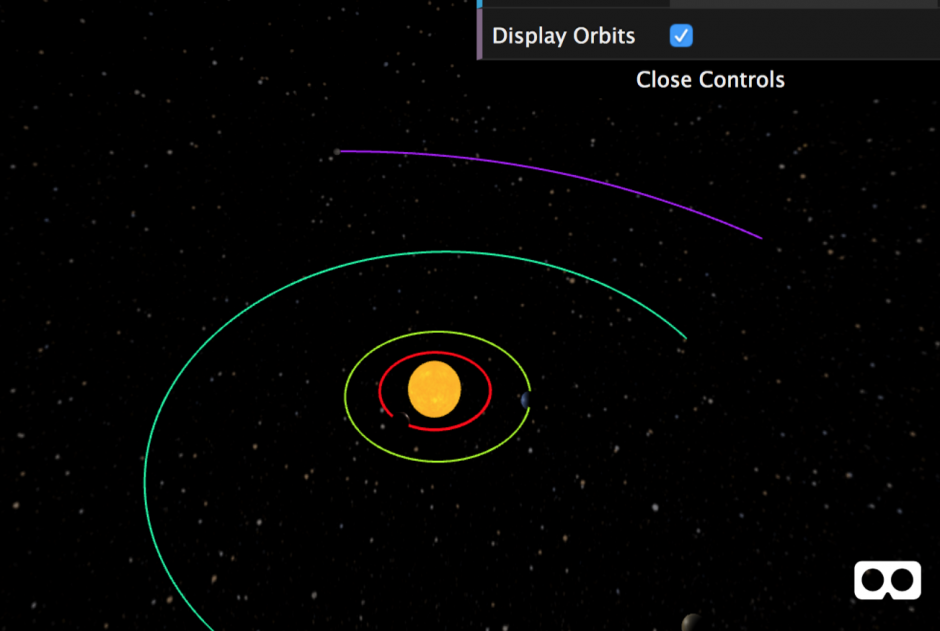HD 114762

HD 114762 is an extrasolar system located 126 ligh-years away in the constellation of Coma Berenices. It is made of two stars and a substellar companion discovered 30 years ago this month. In this animation are represented the primary star (at the center) and the substellar companion (in orbit). The secondary star, much farther away, is not represented.
The system is estimated to be about 12 billion years old, i.e. more than twice as old as the Solar System.
The primary star, HD 114762 A, is a yellow-white main-sequence star (spectral type F9V) less massive than the Sun (0.8 solar masses) but with a larger radius (1.2 solar radii) and a slightly higher temperature (5660 °C, compared to 5500 °C for the Sun). With a magnitude of 7.3, it can be seen with binoculars.
The substellar companion, HD 114762 Ab, has a minimum mass of 11 Jupiter masses, and is therefore either a brown dwarf or a massive planet (“super-Jupiter”). Its discovery, thanks to the radial-velocity technique, was officially announced by David Latham and collaborators, including Michel Mayor and Gilbert Burki from Geneva, on 4 May 1989 [1], i.e. 30 years ago this month. This companion orbits its host star in 84 days, at 0.35 astronomical unit (1 astronomical unit = the Sun-Earth distance), that is on an orbit similar to that of Mercury around the Sun, but more eccentric (0.34 against 0.21 for Mercury)
Finally, the secondary star, HD 114762 B, is likely a red dwarf (uncertain spectral type estimated around M6V). It orbits the primary star at a distance of about 130 astronomical units (about 4 times farther than Neptune from the Sun) and was discovered in 2002 by J. Patience and collaborators [2].
[1]Latham et al., Nature 339:38 (1989), https://www.nature.com/articles/339038a0
[2] Patience et al., Astrophysical Journal 581:654 (2002), https://iopscience.iop.org/article/10.1086/342982/meta.
The system is estimated to be about 12 billion years old, i.e. more than twice as old as the Solar System.
The primary star, HD 114762 A, is a yellow-white main-sequence star (spectral type F9V) less massive than the Sun (0.8 solar masses) but with a larger radius (1.2 solar radii) and a slightly higher temperature (5660 °C, compared to 5500 °C for the Sun). With a magnitude of 7.3, it can be seen with binoculars.
The substellar companion, HD 114762 Ab, has a minimum mass of 11 Jupiter masses, and is therefore either a brown dwarf or a massive planet (“super-Jupiter”). Its discovery, thanks to the radial-velocity technique, was officially announced by David Latham and collaborators, including Michel Mayor and Gilbert Burki from Geneva, on 4 May 1989 [1], i.e. 30 years ago this month. This companion orbits its host star in 84 days, at 0.35 astronomical unit (1 astronomical unit = the Sun-Earth distance), that is on an orbit similar to that of Mercury around the Sun, but more eccentric (0.34 against 0.21 for Mercury)
Finally, the secondary star, HD 114762 B, is likely a red dwarf (uncertain spectral type estimated around M6V). It orbits the primary star at a distance of about 130 astronomical units (about 4 times farther than Neptune from the Sun) and was discovered in 2002 by J. Patience and collaborators [2].
[1]Latham et al., Nature 339:38 (1989), https://www.nature.com/articles/339038a0
[2] Patience et al., Astrophysical Journal 581:654 (2002), https://iopscience.iop.org/article/10.1086/342982/meta.
 Now you can see the animation of the month in virtual reality! For this, you just have to flash the QR code and then put your smartphone in a cardboard.
Now you can see the animation of the month in virtual reality! For this, you just have to flash the QR code and then put your smartphone in a cardboard.

